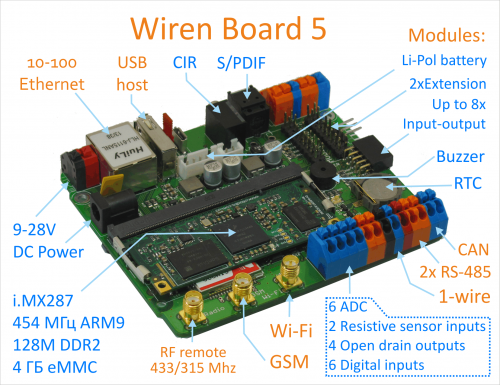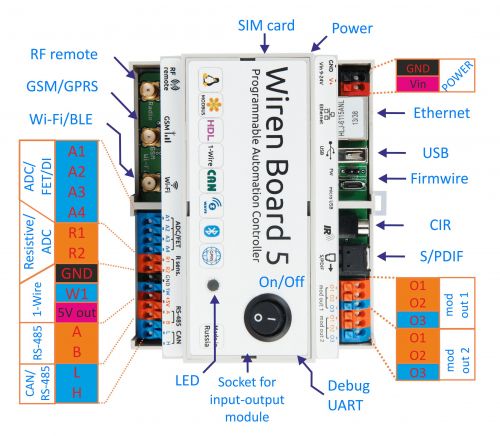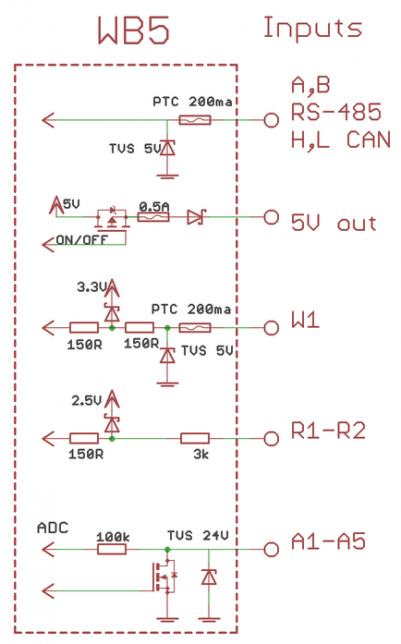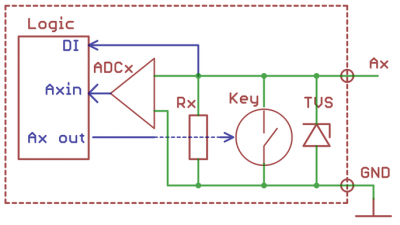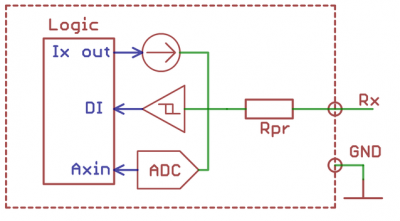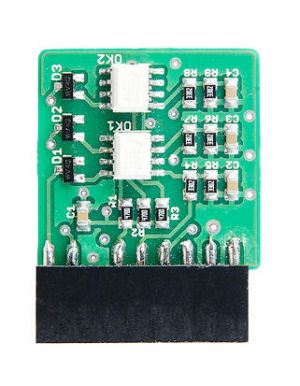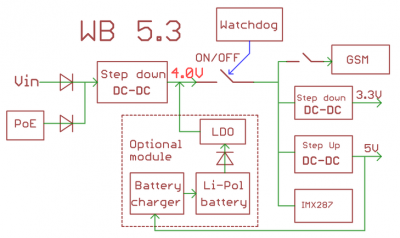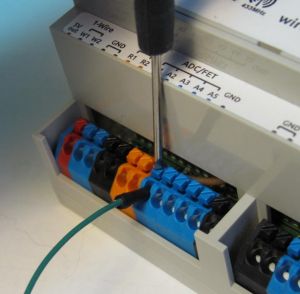Wiren Board 5:Аппаратная часть/en: различия между версиями
(Новая страница: «Some terminal blocks can be used to perform more than one function. See the detailed description of input/output and Special:MyLanguage/Мультиплекси…») |
|||
| (не показано 76 промежуточных версий 3 участников) | |||
| Строка 1: | Строка 1: | ||
<languages/> | <languages/> | ||
[[ | [[Файл:WB5 плата.png| thumb | 500px|Wiren Board 5]] | ||
==Specifications== | ==Specifications== | ||
[[ | [[Файл:WB5 подписи1.jpg| thumb | 500px|Wiren Board 5]] | ||
{| border="1" width="700" class="wikitable" style="text-align:center" | {| border="1" width="700" class="wikitable" style="text-align:center" | ||
| Строка 14: | Строка 14: | ||
|| RAM || DDR2 SDRAM 128 MB | || RAM || DDR2 SDRAM 128 MB | ||
|- | |- | ||
|| ROM || 4 | || ROM || 4 GByte eMMC | ||
|- | |- | ||
| Operating System || Debian Linux 7.0. Mainline kernel 3.19. | | Operating System || Debian Linux 7.0. Mainline kernel 3.19. | ||
| Строка 26: | Строка 26: | ||
{| border="1" width="700" class="wikitable" style="text-align:center" | {| border="1" width="700" class="wikitable" style="text-align:center" | ||
!colspan="2" | '''Wireless Interfaces''' | |||
!colspan="2" | ''' | |||
|- | |- | ||
| [[Special:MyLanguage/Wi-Fi|Wi-Fi]] || 802.11 b/g/n 2.4 | | [[Special:MyLanguage/Wi-Fi|Wi-Fi]] || 802.11 b/g/n 2.4 GHz | ||
|- | |- | ||
|| [[Special:MyLanguage/GSM/GPRS|GSM/GPRS]] || 850/900/1800/1900 | || [[Special:MyLanguage/GSM/GPRS|GSM/GPRS]] || 850/900/1800/1900 MHz. GPRS class 12. 85.6 kbps (downlink). | ||
microSIM card socket. | |||
|- | |- | ||
|| Bluetooth ||4.0, Bluetooth Low Energy | || Bluetooth ||4.0, Bluetooth Low Energy | ||
|- | |- | ||
|| | || ISM Radio || RFM69H module. | ||
To communicate with [[Special:MyLanguage/Поддерживаемые устройства |Noolite]] devices, [[Special:MyLanguage/Поддерживаемые устройства |Oregon]] sensors | |||
|- | |- | ||
|| [[Z-Wave]] || ''( | || [[Special:MyLanguage/Z-Wave|Z-wave]] || ''(optional)'' | ||
|- | |- | ||
|| [[Consumer IR| | || [[Special:MyLanguage/Consumer IR|IR remote]] || ''socket for external IR transceiver'' | ||
|- | |- | ||
|} | |} | ||
| Строка 67: | Строка 67: | ||
{| border="1" width="700" class="wikitable" style="text-align:center" | {| border="1" width="700" class="wikitable" style="text-align:center" | ||
!colspan="2"| ''' | !colspan="2"| '''Sensor connection''' | ||
|- | |- | ||
| 4x[[Special:MyLanguage/ADC | | | 4x[[Special:MyLanguage/ADC | ADC]] || 0-28V range | ||
|- | |- | ||
||2x[[Special:MyLanguage/Входы для резистивных датчиков| | ||2x[[Special:MyLanguage/Входы для резистивных датчиков|Resistive sensor inputs]] | ||
|| | || 10kOhm thermistors are supported. Can also be used as ADC in 0-2.5V range. | ||
|- | |- | ||
|| 4x[[Special:MyLanguage/DI | DI ( | || 4x[[Special:MyLanguage/DI | DI (digital inputs)]] | ||
|- | |- | ||
!colspan="2"| '''Outputs''' | !colspan="2"| '''Outputs''' | ||
|- | |- | ||
| Строка 82: | Строка 81: | ||
|- | |- | ||
|} | |} | ||
{| border="1" width="700" class="wikitable" style="text-align:center" | {| border="1" width="700" class="wikitable" style="text-align:center" | ||
!colspan="2"| '''Other Interfaces''' | !colspan="2"| '''Other Interfaces''' | ||
| Строка 98: | Строка 98: | ||
|- | |- | ||
|} | |} | ||
{| border="1" width="700" class="wikitable" style="text-align:center" | {| border="1" width="700" class="wikitable" style="text-align:center" | ||
!colspan="2"| '''Power supply''' | |||
!colspan="2"| ''' | |||
|- | |- | ||
| | |Supply voltage | ||
|7-28В | |7-28В | ||
|- | |- | ||
| | || Power consumption || < 3 W (peak consumption up to 12 W) | ||
|- | |||
| Backup battery || [[Special:MyLanguage/WBMZ-BATTERY - модуль резервного питания|backup power supply module]] (optional) | |||
|- | |- | ||
|| | ||Passive Power over Ethernet || [[Special:MyLanguage/Power over Ethernet | Passsive Power over Ethernet]] | ||
|- | |- | ||
|} | |} | ||
| Строка 122: | Строка 121: | ||
{| border="1" width="700" class="wikitable" style="text-align:center" | {| border="1" width="700" class="wikitable" style="text-align:center" | ||
| | | | ||
''' | '''legend''' | ||
|| '''Max. V, I''' | || '''Max. V, I''' | ||
| width="10%" | ''' | | width="10%" | '''state''' '''default''' | ||
| width="60%"|''' | | width="60%"|'''Functions''' | ||
|- | |- | ||
! colspan="4"| | ! colspan="4"| Upper row, left block | ||
|- | |- | ||
| '''Vin''' || 28V || || | | '''Vin''' || 28V || ||Input voltage | ||
|- | |- | ||
| '''GND''' || || || | | '''GND''' || || ||power supply ground | ||
|- | |- | ||
! colspan="6"| | ! colspan="6"| Upper row, right block | ||
|- | |- | ||
| '''O1''' || rowspan="3"| || rowspan="3"| || rowspan="3" | | | '''O1''' || rowspan="3"| || rowspan="3"| || rowspan="3" |Inputs/outputs of extension module | ||
|- | |- | ||
| '''O2''' | | '''O2''' | ||
| Строка 142: | Строка 141: | ||
| '''O3''' | | '''O3''' | ||
|- | |- | ||
| '''O1''' || rowspan="3"| || rowspan="3"| || rowspan="3" | | | '''O1''' || rowspan="3"| || rowspan="3"| || rowspan="3" |Inputs/outputs of extension module | ||
|- | |- | ||
| '''O2''' | | '''O2''' | ||
| Строка 148: | Строка 147: | ||
| '''O3''' | | '''O3''' | ||
|- | |- | ||
! colspan="8"| | ! colspan="8"| Lower row, right block | ||
|- | |- | ||
| '''A1''' || rowspan="4"| | | '''A1''' || rowspan="4"| 24V , 2A || rowspan="4"| High Z || rowspan="4" |[[Special:MyLanguage/Управление низковольтной нагрузкой|"Open collector" outputs]], [[Special:MyLanguage/ADC|ADC]] | ||
|- | |- | ||
| '''A2''' | | '''A2''' | ||
| Строка 158: | Строка 157: | ||
| '''A4''' | | '''A4''' | ||
|- | |- | ||
| '''R1''' || rowspan="2"| 5V || rowspan="2"|High Z || rowspan="2" | | | '''R1''' || rowspan="2"| 5V || rowspan="2"|High Z || rowspan="2" |Resistive sensors, [[Special:MyLanguage/ADC|ADC]], digital inputs | ||
|- | |- | ||
| '''R2''' | | '''R2''' | ||
| Строка 166: | Строка 165: | ||
| '''W1''' || 30V || 3.3V || [[Special:MyLanguage/1-Wire|1-Wire]], GPIO | | '''W1''' || 30V || 3.3V || [[Special:MyLanguage/1-Wire|1-Wire]], GPIO | ||
|- | |- | ||
| '''5V out''' || 5V, 0.5A || 5V || | | '''5V out''' || 5V, 0.5A || 5V || 5V output with over-current protection and software on/off control | ||
|- | |- | ||
| '''A''' || 30 V || 0V || rowspan="2"| | | '''A''' || 30 V || 0V || rowspan="2"|connector [[Special:MyLanguage/RS-485|RS-485]] (/dev/ttyAPP1) | ||
|- | |- | ||
| '''B''' || 30 V || +5V | | '''B''' || 30 V || +5V | ||
|- | |- | ||
|- | |- | ||
| '''L''' || 30 V || 0V || rowspan="2"| | | '''L''' || 30 V || 0V || rowspan="2"|connector CAN or [[Special:MyLanguage/RS-485|RS-485]] (/dev/ttyAPP4). | ||
Connection RS-485: A to terminal '''L''', B to terminal '''H'''. | |||
|- | |- | ||
| '''H''' || 30 V || +5V | | '''H''' || 30 V || +5V | ||
| Строка 180: | Строка 179: | ||
|} | |} | ||
== | == Input protection == | ||
# | #All inputs are protected from applying the power supply voltage (up to 24 V) and transient noise. | ||
# | #Wiren Board 5 is protected against reverse polarity | ||
# | #Low-side FET switches on Ax inputs are protected from negative voltage spikes from inductive loads. | ||
== Multifunctional inputs/outputs A1-A4== | |||
[[Файл:Ax2.png|thumb|400px|Equivalent circuit of A1-A4 channels]] | |||
Multifunctional channels consist of input and output stages are connected in parallel, as well as protective diodes (connected to one terminal of the channel). | |||
Output stage consists of the Tx switch. The Tx switch can connect the corresponding output with ground. | |||
The state of the switch is controlled by logic circuits inside the controller. The switch may be one of 2 states: | |||
*Active (closed); channel output is connected to ground (0V). | |||
*Inactive (open), high impedance. | |||
Such outputs are called “open collector” outputs. | |||
Open collector outputs on Ax channels are shown as Ax_OUT in software. Channel address is "wb-gpio/Ax_OUT". | |||
Input stage of Ax channel consists of an analogue-to-digital converter ADCx and an input resistor Rx (100kOhm). | |||
The ADC has a high input impedance, so it doesn't affect the channel operation even if the channel works as output. | |||
In input mode the Tx switch is inactive (open) and, thus, does not affect voltage measuring at the channel terminals. Input impedance in input mode is determined by the Rx resistance. | |||
If the channel terminal is left floating, the input voltage measured by ADCs is pulled down to zero by the Rx resistance. | |||
Analog inputs on Ax channels are shown as "Ax" in software. Channel address is "wb-adc/Ax". | |||
Ax channels also work as discrete inputs. The logical high state is 3V or higher, the logical low is 1.5V or lower. | |||
Binary inputs on Ax channels are shown as "Ax_IN" in software. Channel address is "wb-gpio/Ax_IN". | |||
== R1 and R2 Resistive Inputs== | |||
[[Файл:Rx.png|thumb|400px|Rx equivalent circuit]] | |||
By default each Rx terminal is connected to internal adjustable current source. By measuring the voltage drop across terminals, the Wiren Board software calculates the resistance of the sensor connected to the corresponding terminal. | |||
Each input can also be [[ADC#Измерение сопротивлений|switched]] to a general-purpose analog input. | |||
In this mode, the internal current source is turned off. Voltage measurements in the range of 0-2.5V can be performed. | |||
R1 and R2 inputs also work as discrete inputs. | |||
While the internal current source is activated (as by default) the input is pulled high to the internal 3.3V power rail. | |||
If the input is left floating, the corresponding discrete input state is a logical high. | |||
If the input is connected to the signal ground the input state is a logical zero. | |||
Therefore, external buttons, sensors, etc. should be connected between the Rx and GND terminals. | |||
In the alternate general-purpose ADC mode (with current source disabled), the input is pulled down to the ground. | |||
In this case, a logical zero corresponds to the floating input, while logical high corresponds to the voltage across terminals higher than 2.5V. | |||
In this mode one should connect external buttons, sensors, etc. between the Rx terminal and either "5V out" or positive power supply terminal. | |||
== 1-Wire and +5V output == | |||
1-Wire bus is used for external sensors. The bus utilizes either two or three conductors. | |||
The bus allows to connect multiple devices to a single 1-Wire port in parallel. | |||
You may find convenient to use +5V output to power external sensors or circuits. | |||
The output is protected against short circuit and over-current condition. The output remain fully functional while working on backup battery. | |||
It can also be switched off from the software. | |||
== | == I/O Modules == | ||
I/O modules are connected to Wiren Board 5 side connector on the right. | |||
Up to 8 I/O modules can be connected in series: up to 4 input modules (type I) and up to 4 output modules (types O and IO). Attached I/O modules are automatically detected by the controller. | |||
One can connect up to 4 modules in arbitrary order. Otherwise, one must connect "type I" modules first, then "type O" and "type IO" ones. | |||
The detailed description of the I/O modules can be found in the [[Special:MyLanguage/Модули ввода-вывода|corresponding article]]. | |||
== Extension modules == | |||
[[Файл:EXT1.jpeg|thumb|300px|Extension module]] | |||
On the controller board has two slots for expansion modules. | |||
Each module is assigned to 3 terminals. | |||
When inserted, the extension modules are fixed in place by plastic enclosure. | |||
Please see the following articles for the detailed description: | |||
[[Модули расширения]] | [[Special:MyLanguage/Модули расширения|Extension modules]] | ||
== | == Power Supply == | ||
[[File:WB5 power distribution block diagram.png|thumb|400px| | [[File:WB5 power distribution block diagram.png|thumb|400px|Wiren Board 5 power distribution diagram]] | ||
=== | === External power source === | ||
Allowed supply voltage range is 7-28V. | |||
The average power consumption of the Wiren Board 5 is less than 3W. However the GSM modem can temporally consume up to 8 W. Therefore, it is recommended to use at least 10W power source. | |||
A standard 5.5x2.1mm socket is provided for wall power supply. | |||
Input power can also be supplied to Vin and GND terminals. | |||
=== Power over Ethernet === | === Power over Ethernet === | ||
It is possible to power the device via an Ethernet cable. Ref.[[Special:MyLanguage/Power over Ethernet|Power over Ethernet]]. | |||
=== | === Battery === | ||
Wiren Board | Wiren Board allows to connect internal [[WBMZ-BATTERY - модуль резервного питания | WBMZ-BATTERY backup power supply module ]] with Li-Ion (Li-Pol) battery. | ||
== | == Operation with screw terminals == | ||
[[File:Wago.jpeg|thumb| | [[File:Wago.jpeg|thumb|300px|Working with WAGO 250 terminals]] | ||
Self-tightened clips of "type 250" series are used as interface terminals of the controller. When a stripped single-core wire is inserted into a clip, it is automatically caught by a spring latch. In order to insert multi-core wires, it is necessary to press the clip button to compress the spring. The button is provided with a slot suitable for a flat screw-drive. In order to remove the wire, it is necessary to press the clip button to compress the spring, and then pull the wire out of the clip. | |||
== | == Wi-Fi, GSM, 433MHz antennas == | ||
Wi-Fi, GSM and 433 MHz radio antennas are connected to SMA connectors. | |||
If GSM signal is weak, use of an external antenna is recommended. The external antenna must be located as far from the controller as possible. | |||
Текущая версия на 19:19, 22 марта 2016
Specifications
| General | |
|---|---|
| CPU | Freescale i.MX287 454 MHz ARM9 |
| RAM | DDR2 SDRAM 128 MB |
| ROM | 4 GByte eMMC |
| Operating System | Debian Linux 7.0. Mainline kernel 3.19. |
| Dimensions | 6U DIN-rail mount, 106.25x90.2x57.5 mm.
PCB size: 103x87x20 mm. |
| Operating conditions | Operating temperature- -25...+85 С (-40..+85 С by request). |
| Wireless Interfaces | |
|---|---|
| Wi-Fi | 802.11 b/g/n 2.4 GHz |
| GSM/GPRS | 850/900/1800/1900 MHz. GPRS class 12. 85.6 kbps (downlink).
microSIM card socket. |
| Bluetooth | 4.0, Bluetooth Low Energy |
| ISM Radio | RFM69H module. |
| Z-wave | (optional) |
| IR remote | socket for external IR transceiver |
| Wired Interfaces | |
|---|---|
| Ethernet | 10/100 Mbit/s, 8P8C connector, passive PoE |
| USB 2.0 | Single port. USB Host or USB Device mode of operation. |
| Audio output | S/PDIF Digital audio.
TOSLINK or RCA connector |
| 2xRS-485 | Without galvanic isolation.
Software support for Modbus RTU, Uniel, HDL, various EM-meters protocols included. |
| CAN | multiplexed with one of RS-485. |
| Отладочная консоль | Debug UART USB-UART adapter is used to connect to PC. |
| 1-Wire | For digital temperature sensors |
| Sensor connection | |
|---|---|
| 4x ADC | 0-28V range |
| 2xResistive sensor inputs | 10kOhm thermistors are supported. Can also be used as ADC in 0-2.5V range. |
| 4x DI (digital inputs) | |
| Outputs | |
| 4x"Open collector" | 28V/2A, for driving external contactors, relays, LED strip lights, etc. |
| Other Interfaces | |
|---|---|
| 2xGPIO | are multiplexed with other inputs/outputs |
| 1xBuzzer | buzzer/beeper. |
| Real-time clock | RTC 1220 coin lithium cell |
| Watchdog timer | Separate hardware watchdog to perform full reset of the device |
| 2x Extension module slots | internal |
| 1xI/O module connector | Up to 8 I/O modules are connected in series |
| Power supply | |
|---|---|
| Supply voltage | 7-28В |
| Power consumption | < 3 W (peak consumption up to 12 W) |
| Backup battery | backup power supply module (optional) |
| Passive Power over Ethernet | Passsive Power over Ethernet |
Terminal blocks
Some terminal blocks can be used to perform more than one function. See the detailed description of input/output and the Port multiplexing article.
|
legend |
Max. V, I | state default | Functions | ||||
| Upper row, left block | |||||||
|---|---|---|---|---|---|---|---|
| Vin | 28V | Input voltage | |||||
| GND | power supply ground | ||||||
| Upper row, right block | |||||||
| O1 | Inputs/outputs of extension module | ||||||
| O2 | |||||||
| O3 | |||||||
| O1 | Inputs/outputs of extension module | ||||||
| O2 | |||||||
| O3 | |||||||
| Lower row, right block | |||||||
| A1 | 24V , 2A | High Z | "Open collector" outputs, ADC | ||||
| A2 | |||||||
| A3 | |||||||
| A4 | |||||||
| R1 | 5V | High Z | Resistive sensors, ADC, digital inputs | ||||
| R2 | |||||||
| GND | |||||||
| W1 | 30V | 3.3V | 1-Wire, GPIO | ||||
| 5V out | 5V, 0.5A | 5V | 5V output with over-current protection and software on/off control | ||||
| A | 30 V | 0V | connector RS-485 (/dev/ttyAPP1) | ||||
| B | 30 V | +5V | |||||
| L | 30 V | 0V | connector CAN or RS-485 (/dev/ttyAPP4).
Connection RS-485: A to terminal L, B to terminal H. | ||||
| H | 30 V | +5V | |||||
Input protection
- All inputs are protected from applying the power supply voltage (up to 24 V) and transient noise.
- Wiren Board 5 is protected against reverse polarity
- Low-side FET switches on Ax inputs are protected from negative voltage spikes from inductive loads.
Multifunctional inputs/outputs A1-A4
Multifunctional channels consist of input and output stages are connected in parallel, as well as protective diodes (connected to one terminal of the channel).
Output stage consists of the Tx switch. The Tx switch can connect the corresponding output with ground. The state of the switch is controlled by logic circuits inside the controller. The switch may be one of 2 states:
- Active (closed); channel output is connected to ground (0V).
- Inactive (open), high impedance.
Such outputs are called “open collector” outputs.
Open collector outputs on Ax channels are shown as Ax_OUT in software. Channel address is "wb-gpio/Ax_OUT".
Input stage of Ax channel consists of an analogue-to-digital converter ADCx and an input resistor Rx (100kOhm).
The ADC has a high input impedance, so it doesn't affect the channel operation even if the channel works as output.
In input mode the Tx switch is inactive (open) and, thus, does not affect voltage measuring at the channel terminals. Input impedance in input mode is determined by the Rx resistance.
If the channel terminal is left floating, the input voltage measured by ADCs is pulled down to zero by the Rx resistance.
Analog inputs on Ax channels are shown as "Ax" in software. Channel address is "wb-adc/Ax".
Ax channels also work as discrete inputs. The logical high state is 3V or higher, the logical low is 1.5V or lower.
Binary inputs on Ax channels are shown as "Ax_IN" in software. Channel address is "wb-gpio/Ax_IN".
R1 and R2 Resistive Inputs
By default each Rx terminal is connected to internal adjustable current source. By measuring the voltage drop across terminals, the Wiren Board software calculates the resistance of the sensor connected to the corresponding terminal.
Each input can also be switched to a general-purpose analog input.
In this mode, the internal current source is turned off. Voltage measurements in the range of 0-2.5V can be performed.
R1 and R2 inputs also work as discrete inputs.
While the internal current source is activated (as by default) the input is pulled high to the internal 3.3V power rail. If the input is left floating, the corresponding discrete input state is a logical high.
If the input is connected to the signal ground the input state is a logical zero.
Therefore, external buttons, sensors, etc. should be connected between the Rx and GND terminals.
In the alternate general-purpose ADC mode (with current source disabled), the input is pulled down to the ground. In this case, a logical zero corresponds to the floating input, while logical high corresponds to the voltage across terminals higher than 2.5V.
In this mode one should connect external buttons, sensors, etc. between the Rx terminal and either "5V out" or positive power supply terminal.
1-Wire and +5V output
1-Wire bus is used for external sensors. The bus utilizes either two or three conductors. The bus allows to connect multiple devices to a single 1-Wire port in parallel.
You may find convenient to use +5V output to power external sensors or circuits.
The output is protected against short circuit and over-current condition. The output remain fully functional while working on backup battery. It can also be switched off from the software.
I/O Modules
I/O modules are connected to Wiren Board 5 side connector on the right.
Up to 8 I/O modules can be connected in series: up to 4 input modules (type I) and up to 4 output modules (types O and IO). Attached I/O modules are automatically detected by the controller.
One can connect up to 4 modules in arbitrary order. Otherwise, one must connect "type I" modules first, then "type O" and "type IO" ones.
The detailed description of the I/O modules can be found in the corresponding article.
Extension modules
On the controller board has two slots for expansion modules. Each module is assigned to 3 terminals.
When inserted, the extension modules are fixed in place by plastic enclosure.
Please see the following articles for the detailed description:
Power Supply
External power source
Allowed supply voltage range is 7-28V. The average power consumption of the Wiren Board 5 is less than 3W. However the GSM modem can temporally consume up to 8 W. Therefore, it is recommended to use at least 10W power source.
A standard 5.5x2.1mm socket is provided for wall power supply.
Input power can also be supplied to Vin and GND terminals.
Power over Ethernet
It is possible to power the device via an Ethernet cable. Ref.Power over Ethernet.
Battery
Wiren Board allows to connect internal WBMZ-BATTERY backup power supply module with Li-Ion (Li-Pol) battery.
Operation with screw terminals
Self-tightened clips of "type 250" series are used as interface terminals of the controller. When a stripped single-core wire is inserted into a clip, it is automatically caught by a spring latch. In order to insert multi-core wires, it is necessary to press the clip button to compress the spring. The button is provided with a slot suitable for a flat screw-drive. In order to remove the wire, it is necessary to press the clip button to compress the spring, and then pull the wire out of the clip.
Wi-Fi, GSM, 433MHz antennas
Wi-Fi, GSM and 433 MHz radio antennas are connected to SMA connectors.
If GSM signal is weak, use of an external antenna is recommended. The external antenna must be located as far from the controller as possible.
